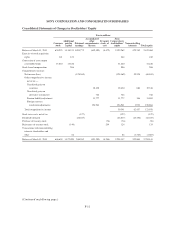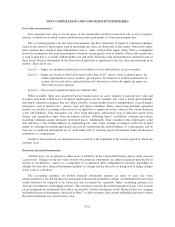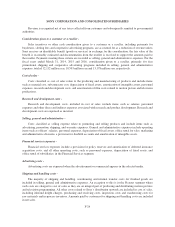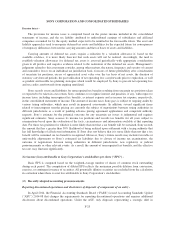Sony 2015 Annual Report Download - page 153
Download and view the complete annual report
Please find page 153 of the 2015 Sony annual report below. You can navigate through the pages in the report by either clicking on the pages listed below, or by using the keyword search tool below to find specific information within the annual report.SONY CORPORATION AND CONSOLIDATED SUBSIDIARIES
goodwill with the carrying amount of that goodwill. If the carrying amount of the reporting unit’s goodwill
exceeds the implied fair value of that goodwill, an impairment loss is recognized in an amount equal to that
excess. The implied fair value of goodwill is determined in the same manner as the amount of goodwill
recognized in a business combination. That is, the fair value of the reporting unit is allocated to all of the assets
and liabilities of that unit (including any unrecognized intangible assets) as if the reporting unit had been
acquired in a business combination and the fair value of the reporting unit was the purchase price paid to acquire
the reporting unit. Indefinite lived intangible assets are tested for impairment by comparing the fair value of the
intangible asset with its carrying value and if the carrying value of the intangible asset exceeds its fair value, an
impairment loss is recognized in an amount equal to that excess.
The fair value of a reporting unit or indefinite lived intangible asset is generally determined using a
discounted cash flow analysis. This approach uses significant estimates and assumptions, including projected
future cash flows, the timing of such cash flows, discount rates reflecting the risk inherent in future cash flows,
perpetual growth rates, earnings multiples, the determination of appropriate comparable entities and the
determination of whether a premium or discount should be applied to comparables. Consideration is also given to
Sony’s market capitalization in relation to the sum of the calculated fair values of the reporting units, including
reporting units with no goodwill, and taking into account corporate level assets and liabilities not assigned to
individual reporting units as well as a reasonable control premium.
The assumptions used for projected future cash flows and the timing of such cash flows are based on the
forecast and mid-range plan (“MRP”) of each reporting unit and take into account such factors as historical
experience, market and industry information, and current and forecasted economic conditions. Perpetual growth
rates are utilized to determine a terminal cash flow value and are generally set after the three-year forecasted
period for the MRP. Certain reporting units, such as those in the Pictures segment, utilize longer forecast periods
and base the terminal value on an exit price using an earnings multiple with a control premium applied to the
final year of the projected cash flows. Discount rates are derived from the weighted average cost of capital of
market participants in similar businesses.
When a business within a reporting unit is disposed of, goodwill is allocated to the disposed business using
the relative fair value method.
Intangible assets with finite useful lives mainly consist of patent rights, know-how, license agreements,
customer relationships, trademarks, software to be sold, leased or otherwise marketed, internal-use software,
music catalogs, artist contracts, and television carriage contracts (broadcasting agreements). Patent rights,
know-how, license agreements, trademarks, software to be sold, leased or otherwise marketed, and internal-use
software are generally amortized on a straight-line basis over three to 10 years. Customer relationships, music
catalogs, artist contracts and television carriage contracts (broadcasting agreements) are amortized on a
straight-line basis, generally, over 10 to 40 years.
Capitalized software -
The costs related to establishing the technological feasibility of software to be sold, leased, or otherwise
marketed are expensed as incurred as a part of research and development in cost of sales. Costs that are incurred
to produce the finished product after technological feasibility is established are capitalized and amortized to cost
of sales over the estimated economic life, which is generally three years. The technological feasibility of game
software is established when the product master is completed. Consideration to capitalize game software
development costs before this point is limited to the development costs of games for which technological
feasibility can be proven at an earlier stage. At each balance sheet date, Sony performs reviews to ensure that
unamortized capitalized software costs remain recoverable from future profits of the related software products.
The costs incurred for internal-use software during the application development stage are capitalized and
amortized, mainly to selling, general and administrative expenses, on a straight-line basis over the estimated
useful life. Costs related to the preliminary project stage and post implementation activities are expensed as
incurred.
F-19
























